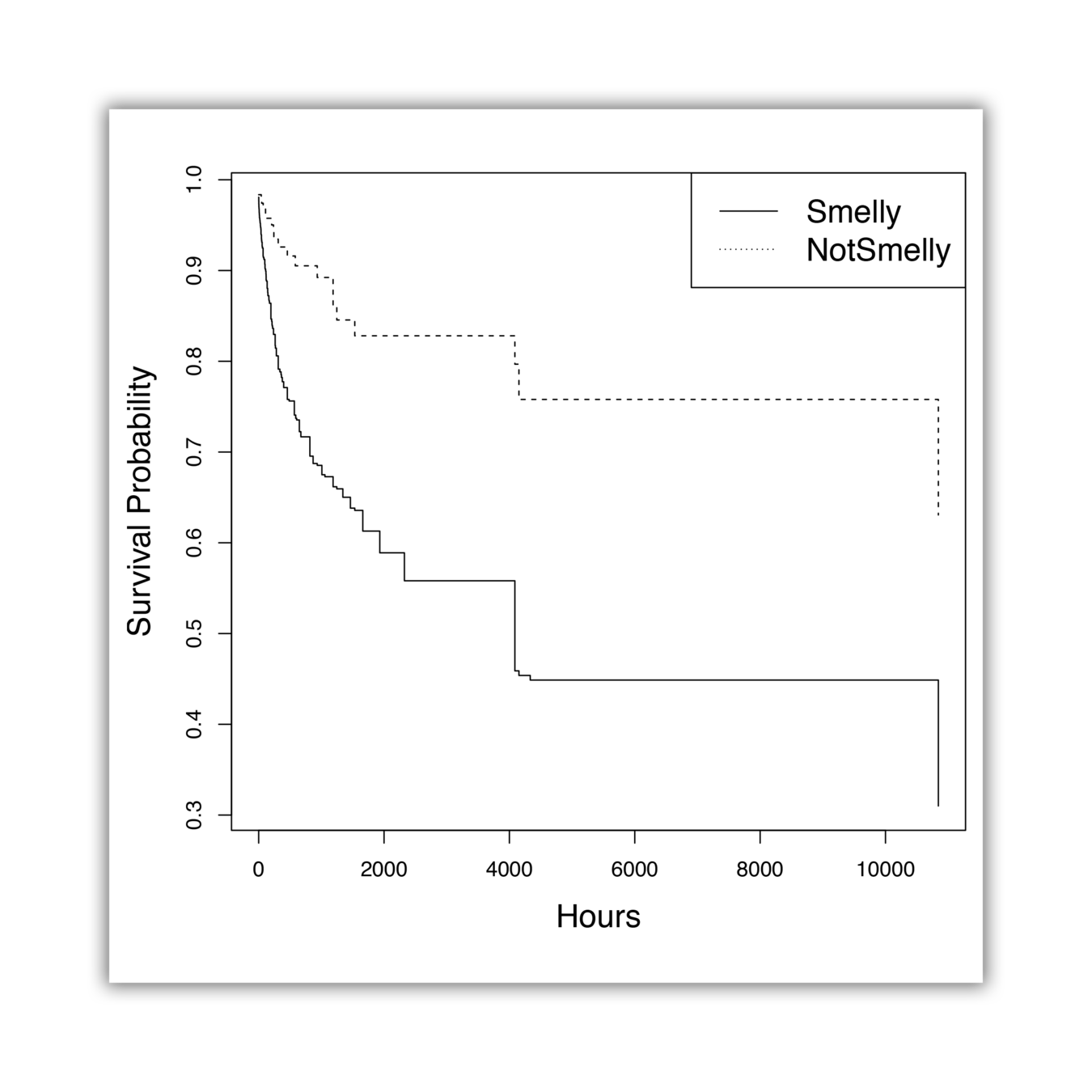On the fault-proneness of
JavaScript Code Smells

Amir Saboury
December 2016
Outline
- Introduction & Background
- Research Objectives
- Literature Review
- Methodology & Design
- Study Results
- Discussion
- Conclusion
- Limitations
- Introduction & Background
- Research Objectives
- Literature Review
- Methodology & Design
- Study Results
- Discussion
- Conclusion
- Limitations
JavaScript


- Introduction & B ackground
- Research Objectives
- Literature Review
- Methodology & Design
- Study Results
- Discussion
- Conclusion
- Limitations

- Introduction & Background
- Research Objectives
- Literature Review
- Methodology & Design
- Study Results
- Discussion
- Conclusion
- Limitations
Code Smell
The pieces of the codes that scream out to be refactored
– Martin Fowler
- Introduction & Background
- Research Objectives
- Literature Review
- Methodology & Design
- Study Results
- Discussion
- Conclusion
- Limitations
- Introduction & Background
- Research Objectives
- Literature Review
- Methodology & Design
- Study Results
- Discussion
- Conclusion
- Limitations
Research Objectives
RQ1
Is the risk of fault higher in files with code smells in comparison with those without smell?
- Introduction & Background
- Research Objectives
- Literature Review
- Methodology & Design
- Study Results
- Discussion
- Conclusion
- Limitations
RQ2
Are JavaScript files with code smells
equally fault-prone?
- Introduction & Background
- Research Objectives
- Literature Review
- Methodology & Design
- Study Results
- Discussion
- Conclusion
- Limitations
JavaScript Code Smells
- Introduction & Background
- Research Objectives
- Literature Review
- Methodology & Design
- Study Results
- Discussion
- Conclusion
- Limitations
- The detection of code smells.
- The evolution of code smells in software systems and their impact on software quality.
- The relationship between code smells and software development activities.
Types of Code Smells
JSNose



- Introduction & Background
- Research Objectives
- Literature Review
- Methodology & Design
- Study Results
- Discussion
- Conclusion
- Limitations


#1
Lengthy Lines
- Introduction & Background
- Research Objectives
- Literature Review
- Methodology & Design
- Study Results
- Discussion
- Conclusion
- Limitations
#2
Chained Methods
$('a').find('span').attr('id', 'title').end().click();- Introduction & Background
- Research Objectives
- Literature Review
- Methodology & Design
- Study Results
- Discussion
- Conclusion
- Limitations
#3
Long Parameter List
move(x1, y1, x2, y2, direction, speed, steps, onFinish)- Introduction & Background
- Research Objectives
- Literature Review
- Methodology & Design
- Study Results
- Discussion
- Conclusion
- Limitations
#4
Nested Callbacks
$.get('/info.json', function (err, data) {
log(data, function (err, data) {
// ...
});
});
- Introduction & Background
- Research Objectives
- Literature Review
- Methodology & Design
- Study Results
- Discussion
- Conclusion
- Limitations
#5
Variable Re-assign
function parse(url) {
url = url.split('/');
// ...
}- Introduction & Background
- Research Objectives
- Literature Review
- Methodology & Design
- Study Results
- Discussion
- Conclusion
- Limitations
#6
Assignment in Conditional Statements
if (element = stack.pop()){
element.addClass("last");
}- Introduction & Background
- Research Objectives
- Literature Review
- Methodology & Design
- Study Results
- Discussion
- Conclusion
- Limitations
#7
Complex code

- Introduction & Background
- Research Objectives
- Literature Review
- Methodology & Design
- Study Results
- Discussion
- Conclusion
- Limitations
cyclomatic complexity
#8
Extra Bind
var download = function (url) {
var callback = function (err, data) {
// this.data = data;
console.log(data);
}.bind(this);
$get(url, callback);
}- Introduction & Background
- Research Objectives
- Literature Review
- Methodology & Design
- Study Results
- Discussion
- Conclusion
- Limitations
#9
"this" Assign
var download = function (url) {
var self = this;
var callback = function (err, data) {
self.error = err;
self.data = data;
}
$get(url, callback);
}- Introduction & Background
- Research Objectives
- Literature Review
- Methodology & Design
- Study Results
- Discussion
- Conclusion
- Limitations
#10
Long Methods


* https://sourcemaking.com/refactoring
- Introduction & Background
- Research Objectives
- Literature Review
- Methodology & Design
- Study Results
- Discussion
- Conclusion
- Limitations
#11
Complex Switch Case

* https://sourcemaking.com/refactoring
- Introduction & Background
- Research Objectives
- Literature Review
- Methodology & Design
- Study Results
- Discussion
- Conclusion
- Limitations
#12
Depth
var download = function (url) {
if (url) {
$get(url, function(err, data) {
if (!err) {
if (data.includes('http')) {
//...
}
}
});
}
}- Introduction & Background
- Research Objectives
- Literature Review
- Methodology & Design
- Study Results
- Discussion
- Conclusion
- Limitations
Methodology & Design
- Introduction & Background
- Research Objectives
- Literature Review
- Methodology & Design
- Study Results
- Discussion
- Conclusion
- Limitations
Studied Systems, Data Extraction, Analysis
Studied Systems
- Express Web framework
- Request HTTP client utility
- Less.js CSS pre-processor
- Bower.io Package manager
- Grunt Task Runner
- Introduction & Background
- Research Objectives
- Literature Review
- Methodology & Design
- Study Results
- Discussion
- Conclusion
- Limitations
Data Extraction

- Introduction & Background
- Research Objectives
- Literature Review
- Methodology & Design
- Study Results
- Discussion
- Conclusion
- Limitations


- Introduction & Background
- Research Objectives
- Literature Review
- Methodology & Design
- Study Results
- Discussion
- Conclusion
- Limitations
var a = 42;
var b = 5;
function addA(d) {
return a + d;
}
var c = addA(2) + b;Abstract Source Tree

- Introduction & Background
- Research Objectives
- Literature Review
- Methodology & Design
- Study Results
- Discussion
- Conclusion
- Limitations
Data Extraction
File
comit
comit
comit
comit
comit
bug inducing
bug fixing
- Introduction & Background
- Research Objectives
- Literature Review
- Methodology & Design
- Study Results
- Discussion
- Conclusion
- Limitations
Data Extraction

- Introduction & Background
- Research Objectives
- Literature Review
- Methodology & Design
- Study Results
- Discussion
- Conclusion
- Limitations
Code Smell Detection
- Extra Bind
- This Assign
- Assignment in Conditional Statements
- Variable Re-assign
- Lengthy Lines
- Chained Methods
- Long Parameter List
- Nested Callbacks
- Complex code
- Long Methods
- Complex Switch Case
- Depth
Boolean
Number
- Introduction & Background
- Research Objectives
- Literature Review
- Methodology & Design
- Study Results
- Discussion
- Conclusion
- Limitations
Code Smell Detection
Metrics
Code Smells

grunt - nested callbacks

- Introduction & Background
- Research Objectives
- Literature Review
- Methodology & Design
- Study Results
- Discussion
- Conclusion
- Limitations
Data Extraction

- Introduction & Background
- Research Objectives
- Literature Review
- Methodology & Design
- Study Results
- Discussion
- Conclusion
- Limitations
Survival Analysis
Models how long subjects under observation can survive before the occurrence of an event of interest.
- Introduction & Background
- Research Objectives
- Literature Review
- Methodology & Design
- Study Results
- Discussion
- Conclusion
- Limitations
Cox Proportional Hazard Model
Survival Analysis
Cox Proportional Hazard Model
- Subjects can remain in the model for the entire observation period.
- Subjects can be grouped according to a covariate (smelly or non-smelly).
- The characteristics of the subjects might change during the observation period (e.g., size of code).
- Cox hazard models are adapted for events that are recurrent.
- Introduction & Background
- Research Objectives
- Literature Review
- Methodology & Design
- Study Results
- Discussion
- Conclusion
- Limitations
Data Extraction

- Introduction & Background
- Research Objectives
- Literature Review
- Methodology & Design
- Study Results
- Discussion
- Conclusion
- Limitations
Study Results
- Introduction & Background
- Research Objectives
- Literature Review
- Methodology & Design
- Study Results
- Discussion
- Conclusion
- Limitations
RQ1
Is the risk of fault higher in files with code smells in comparison with those without smell?
Approach
Time:
The number of hours between the previous revision and the revision r.
For each file f and revision r:
Covariate of interest:
The presence of a code smell in the file f in the revision r.
Event:
Is the revision r a fault-fixing change?
survfit & coxph
- Introduction & Background
- Research Objectives
- Literature Review
- Methodology & Design
- Study Results
- Discussion
- Conclusion
- Limitations
There is no difference between the probability of a fault occurrence in a file containing code smells and a file without code smells.
Null hypotheses:
- Introduction & Background
- Research Objectives
- Literature Review
- Methodology & Design
- Study Results
- Discussion
- Conclusion
- Limitations

Request

Less.js

Grunt

Express

Bower
- Introduction & Background
- Research Objectives
- Literature Review
- Methodology & Design
- Study Results
- Discussion
- Conclusion
- Limitations
Log-rank Test
(which compares the survival distributions of two samples)
p-value < 0.05
hypothesis rejected
| JavaScript files without code smells have hazard rates 65% lower than JavaScript files with code smells and this difference is statistically significant. |
|---|
- Introduction & Background
- Research Objectives
- Literature Review
- Methodology & Design
- Study Results
- Discussion
- Conclusion
- Limitations
Study Results
RQ2
Are JavaScript files with code smells
equally fault-prone?
- Introduction & Background
- Research Objectives
- Literature Review
- Methodology & Design
- Study Results
- Discussion
- Conclusion
- Limitations
Approach
Time, Event
Smelly i
If the file has the code smell type i
LOC, Code Churn, and the number of past bugs
- Introduction & Background
- Research Objectives
- Literature Review
- Methodology & Design
- Study Results
- Discussion
- Conclusion
- Limitations
The hazard ratios of the studied code smells vary across the systems
Express
Chained Methods, This Assign, Variable Re-assign, and #Past-bugs
Grunt
Nested Callbacks, Assignment in Conditional Statements, and Variable Re-assign
Bower
Depth, #Past-bugs, and LOC
Less.js
Assignment in Conditional Statements, and #Past-bugs
Request
Variable Re-assign, and #Past-bugs
- Introduction & Background
- Research Objectives
- Literature Review
- Methodology & Design
- Study Results
- Discussion
- Conclusion
- Limitations
| JavaScript files containing different types of code smells are not equally fault-prone. Developers should consider refactoring files containing "Variable Re-assign" code smell and "Assignment in Conditional Statements" code smell in priority since they seem to increase the risk of faults in the system. |
|---|
- Introduction & Background
- Research Objectives
- Literature Review
- Methodology & Design
- Study Results
- Discussion
- Conclusion
- Limitations
Discussion
- Introduction & Background
- Research Objectives
- Literature Review
- Methodology & Design
- Study Results
- Discussion
- Conclusion
- Limitations
Survey
https://srvy.online
Shared in HackerNews & EchoJS
- Introduction & Background
- Research Objectives
- Literature Review
- Methodology & Design
- Study Results
- Discussion
- Conclusion
- Limitations
Survey
1484
Participants
- Introduction & Background
- Research Objectives
- Literature Review
- Methodology & Design
- Study Results
- Discussion
- Conclusion
- Limitations
Survey
92% used JS for client-side applications
51% used JS for server-side applications
68% 3+ years of experience with JavaScript
Nested Callbacks (8.1/10)
Variable Re-assign (6.5/10)
Long Parameter List (6.2/10)
- Introduction & Background
- Research Objectives
- Literature Review
- Methodology & Design
- Study Results
- Discussion
- Conclusion
- Limitations
Conclusion
Quantitative study of 5 JavaScript systems
JS files without code smells have hazard rates 65% lower than JavaScript files with code smells
"Variable Re-assign" and "Assignment in Cond. Statements" code smells have the highest hazard rates
Qualitative study with 1484 JS developers
Nested Callbacks, Variable Re-assign, Long Parameter List
- Introduction & Background
- Research Objectives
- Literature Review
- Methodology & Design
- Study Results
- Discussion
- Conclusion
- Limitations
Limitations
-
Findings bug-fixing commits ("bug", "fix", "defect" etc)
-
SZZ heuristic
-
Presence of the smell in the file as a whole
-
AST provided by ESLint
-
Logarithmic link function
-
5 JS Systems

?
Thank you

Copy of js-smell
By amir
Copy of js-smell
- 1,320



